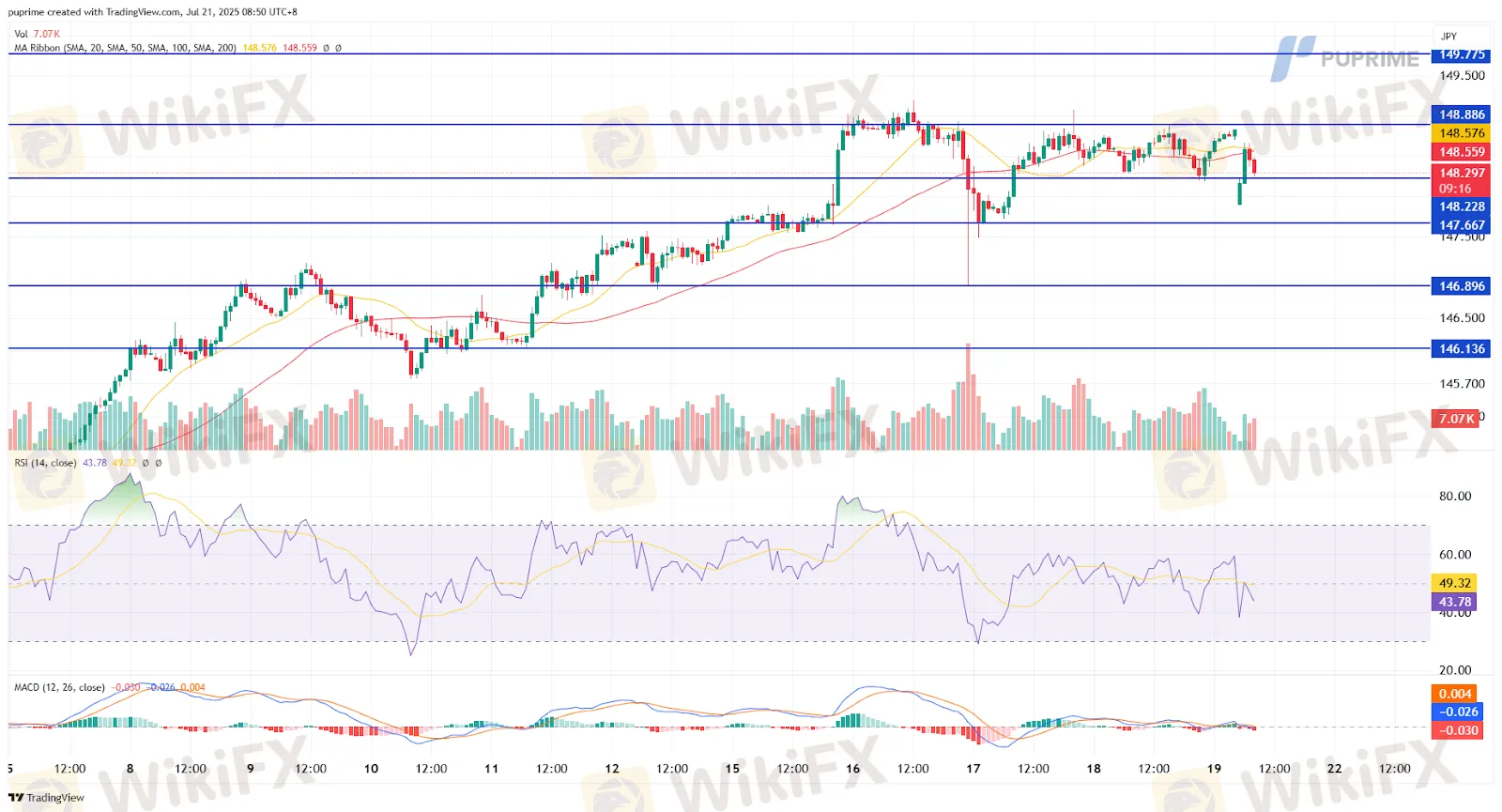简体中文
繁體中文
English
Pусский
日本語
ภาษาไทย
Tiếng Việt
Bahasa Indonesia
Español
हिन्दी
Filippiiniläinen
Français
Deutsch
Português
Türkçe
한국어
العربية
Yen Weighed Down by Political and Trade Uncertainty
Sommario:Key Takeaways:Political instability is rising as PM Ishibas coalition risks losing its upper house majority.Inflation pressures remain acute for households, while the BoJ resists policy normalization.
Key Takeaways:
Political instability is rising as PM Ishibas coalition risks losing its upper house majority.
Inflation pressures remain acute for households, while the BoJ resists policy normalization.
Trade tensions with the U.S. and the August 1 auto tariff deadline threaten Japans export-reliant economy.
Market Summary:
The Japanese yen remains under pressure as political and economic uncertainty intensify ahead of critical domestic and international deadlines. Markets are bracing for potential fallout from Sunday‘s upper house election, where Prime Minister Ishiba’s ruling coalition is expected to lose its majority. The anticipated shift in the political landscape—driven by voter frustration over surging food prices and declining real wages—could have significant implications for Japans fiscal path and central bank policy.
June inflation data underscored the tension between headline moderation and household stress. While core CPI slowed to 3.3%, food staples like rice soared 99.2% YoY, becoming a flashpoint issue in the campaign. Opposition parties, led by the populist Reiwa Party, are pushing for consumption tax cuts and expanded fiscal spending—moves that could steepen the JGB yield curve and challenge Japans debt sustainability, which already stands at over 250% of GDP.
The Bank of Japan has so far resisted calls to normalize policy, holding its short-term rate at 0.5% despite 39 consecutive months of above-target inflation. However, market pressures are building. Yields on 30-year JGBs have climbed to 3.20%—near record highs—raising doubts about the durability of the BoJs yield curve control strategy. A change in political leadership or a shift in fiscal priorities could force the central bank into action sooner than anticipated.
Externally, the yen remains exposed to trade risk, with the August 1 deadline for the U.S.-Japan auto and steel tariffs approaching. Failure to strike a deal could severely hit Japans export-heavy economy, particularly if the U.S. follows through on its threat of 25% sector-wide tariffs.
In the near term, USD/JPY could break above key resistance at 149.70 if tariff risks materialize or if post-election uncertainty triggers capital outflows. Conversely, any surprise BoJ shift or signs of political clarity could offer the yen a reprieve. Until then, the JPY remains caught in a dangerous nexus of political instability, inflation stress, and policy paralysis.
Technical Analysis

USD/JPY, H4:
USD/JPY has come under renewed pressure, breaking below the 148.88 support region after multiple failed attempts to hold above the 20- and 50-period moving averages. The pair is currently consolidating just above the 147.70 horizontal support zone, following a swift bearish rejection from the 148.88 resistance area. The drop was accompanied by increased bearish volume, hinting at a potential shift in momentum after a prolonged range-bound phase.
Technical indicators lean bearish. The RSI has slipped to 44, confirming a break beneath the midline and suggesting waning bullish momentum. Meanwhile, the MACD has crossed below the signal line with the histogram printing deeper negative bars, reinforcing the bearish tilt. Price action also shows sellers asserting control as the pair trades firmly below both short-term moving averages, with the 20-SMA beginning to curve downward, which is a sign of possible short-term trend reversal.
A daily close below 147.70 would likely expose the pair to further downside toward the next key support at 146.90 in extension. On the flip side, any recovery attempts toward the 148.88 zone could face strong resistance, as that region now acts as a barrier following the recent breakdown.
Resistance Levels: 148.88, 149.80
Support Levels: 148.30, 147.70
Disclaimer:
Le opinioni di questo articolo rappresentano solo le opinioni personali dell’autore e non costituiscono consulenza in materia di investimenti per questa piattaforma. La piattaforma non garantisce l’accuratezza, la completezza e la tempestività delle informazioni relative all’articolo, né è responsabile delle perdite causate dall’uso o dall’affidamento delle informazioni relative all’articolo.
WikiFX Trader
AvaTrade
STARTRADER
IC Markets Global
OANDA
BG SAXO
EC Markets
AvaTrade
STARTRADER
IC Markets Global
OANDA
BG SAXO
EC Markets
WikiFX Trader
AvaTrade
STARTRADER
IC Markets Global
OANDA
BG SAXO
EC Markets
AvaTrade
STARTRADER
IC Markets Global
OANDA
BG SAXO
EC Markets
Rate Calc


